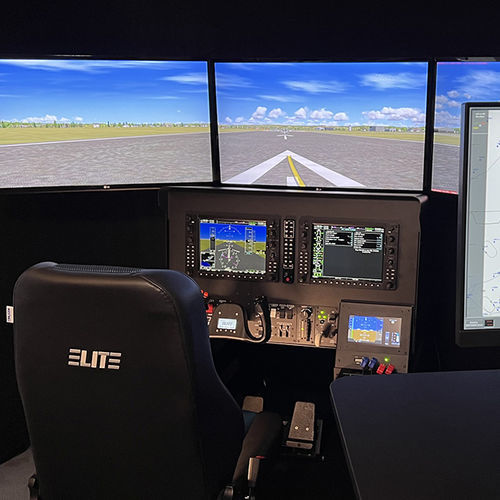
#Product Trends
The diverse and important impact of (flight) simulators in the fields of research, ATC training and other non-aeronautical fields
by Aviation Journalist Stephan Mark Stirnimann
The benefits of our world-renowned simulators for flight schools and other flight training or operating organizations are clear to both students and professional pilots. That is why we are the top address when finding a tailor-made simulator – built to satisfy the customer.
So let us focus in this article on the role a simulator has in other fields of research such as at Universities (A) and higher education institutions, as well as the Air Traffic Control (B) departments and even the combination of «medicine with machine» using simulators as a therapeutic way (C) to cure human illnesses, including traumatic phobias.
Simulators and their increasing role in Universities and other educational institutions (A)
Undergraduate and postgraduate Aeronautics and Astronautics students are being trained to observe the important role of aircraft design and its influence on handling of an aircraft. Most Universities set the focus in the first year of the degree on design, testing and manufacturing of an aircraft. Thanks to a (flight) simulator at hand, these students have the exclusive opportunity of flying a variety of aircraft. The different aircraft types on each simulator vary depending on customer wishes. This means, they can experience directly and «out of first hand» how major aspects of an aircraft design influence the handling qualities (known as the laboratory phase). In the last two years of their studies, the students are normally able to use the simulators once again for individual tasks and group design projects.
Universities are very keen on observing human-to-machine interaction, analyzing aeroacoustics of aircraft, but also rotorcraft and biologically inspired flying vehicles. It is clear, that nowadays students are in a much better situation when provided with a (flight) simulator. Have a look at the generic ELITE FNPT II or the FTD, which is a simulator device, that has been specifically designed and built by our engineers. They can now study, learn and work in an environment that previously would have only been made accessible by very expensive full motion (flight) simulators or by sitting in a real aircraft, thus resulting in high fuel and maintenance costs.
A further benefit for higher education institutes using a simulator is how easy our generic and reconfigurable devices can be switched between aircraft types and systems. This is a huge learning step for students who can now evaluate, observe and recognize the handling characteristics of different aircraft. It enables them to enter their study phase of planning and engineering of future system designs. These engineering research simulators are going to be a game changer for a University, college or high school that wants to be even more valued and sought for by students.
Opting for a (flight) simulator gives an institution such as a University or training college the following educational benefits:
Bridging theory with simulator advantages: Reach a higher student learning growth by comparing theoretical and practical ideas in a much faster way because the student and professor can test their models of thinking in the (flight) simulator.
Familiarization with the cockpit: Save a big amount of fuel and maintenance costs by enabling your students and future pilots their first familiarization with avionics, control units and their whole new aviation experience in the (flight) simulator.
Working in a customer-built simulator: Your students will be thrilled by a tailor-made simulator which can be built matching the criteria of your University, academy or flight school while increasing the efficiency of the learning period (time is money)
Simultaneous training for multiple students: No more queuing lists and time being lost looking for a free training place for one simulator only. We have the knowledge to design and create your virtual classroom and build several (flight) simulators which can all be used at the same time. Just imagine practicing flying a formation with your students.
Interesting research and scientific benefits of operating a simulator:
Validate your theory with the help of a simulator: Is my research going in the right direction and can my thesis and ideas be implemented in a flying situation? Where can I optimize my research? With our tailor-made (flight) simulator, you can verify your theories in a 1:1 flying environment on a multiple number of aircraft and helicopter flights.
Practice results can contribute towards research: There is no need to rent an external expensive (flight) simulator. The scientists can validate their results directly at the institution where the simulators are situated. If the outcome is different, the students and their tutors can easily and without any delay adjust their theories.
Research and compare worldwide with a (flight) simulator: International research results can actually be «tested» and confirmed in the own customer-built simulator. This solution offers a detailed analysis of student work and enables cooperation with other Universities and similar educational institutions in order to achieve the best results.
Find completely new solutions through a different angle: Thanks to the possibility of «close to reality» simulator training, students receive feedback from a different kind of perspective by experimenting with practical issues (such as stalling an aircraft or landing on an aircraft carrier). These students will develop – through this «playful» element of lessons – a completely new level of awareness, which increases their self-confidence and problem-solving attitude.
Below you find an example of how we can provide a University or other equivalent research center with a (flight) simulator to improve your lessons in an efficient way.
The PI-135 Basic ATD is our most affordable, fully procedural system, which can be used for complete startup, flight, and shutdown procedures. You can even use the PI-135 to perform the approaches, holding procedures. Furthermore, you can use, change and adapt your own flight data so you can immediately use your theoretical data and test it. It gives you the chance to teach, learn or react in an efficient time. There is also the possibility of an upgrade to a professional convertible BATD.
This sophisticated system is recommended for instructors, flight schools or Universities that want complete procedural training capabilities in a moderate price range. It is also great for introducing non-instrument students to basic aircraft operating procedures. The «Pro Panel» is equipped with a Hobbs meter and panel ON and OFF key lock which makes it a good choice for Universities that want to closely monitor the simulator usage time.
This FAA certified Basic ATD system is approved for the following credits:
- 2.5 hours toward Private rating
- 10 hours toward Instrument rating
- Recency of Flight Experience (RFE) Instrument
Reference: Buckinghamshire New University (United Kingdom)
The School of Aviation and Security at the prestigious Buckinghamshire New University in the United Kingdom boasts an ELITE S812 FNPT II (flight) simulator. This features a single pilot, fully enclosed spacious cockpit with a fully integrated enclosed instructor station as well as an external visual system and can be used for instrument training, simulator practice, supporting theoretical training, introductions to CRM, research projects or for company training (e.g. away days) and school visits.
It is clear, that with a (flight) simulator your University program will be automatically enhanced by this technical state of the art device. You as an operator will run a unique engineering research flight simulation department while undertaking a wide variety of research programs in fields of science such as avionics, flight control systems and human factors. This multi-disciplinary approach to aeronautics gives students and tutors an opportunity to:
design, build and evaluate future air traffic environments,
develop highly advanced pilot advisory systems,
evaluate state of the art pilot situation awareness displays,
examine and evaluate the dynamics and handling qualities of future aircraft concepts, flight dynamics and control challenges all with the help of piloted studies.
The professional use of simulators on Air Traffic Control (B)
Let us now have a look how our Air Traffic Procedures Simulator (ATPS) can enhance ATC training and supervision levels and help both students and operators achieve a much greater learning growth.
Practice ATC procedures: An ATPS is the ideal enabler to introduce and validate new ATC procedures and to educate air traffic controllers on pilot and co-pilot procedures during take-off and landing phases.
ATC organization: The ATPS supports ATC organizations to make sure that new procedures and materials evaluated on the ATC side are truly ready for use on the airside.
Different view and perspective: Each Air Traffic Controller is able to step into pilot «shoes» and spend enough hours in a highly realistic Airbus A320 cockpit environment.
Validation of ATC / Navigation Enhancements, for instance examining the transition from performance based navigation to ground based augmentation systems.
Investigation of new concepts of air to ground cooperation by using Airborne Separation Assurance Systems (ASAS).
Evaluation and Assessment of air to ground interaction when using 4D trajectories. Trajectory based operations (TBO) is an air traffic management (ATM) method for strategically planning and managing flights throughout the operation by using time-based management (TBM) information exchanged between air and ground systems, and the aircraft's ability to fly trajectories in time and space.
We are very proud to have two large and important customers, namely the Eurocontrol ATC in Paris and the Deutsche Flugsicherung (DFS) in Germany.
The benefits of simulator aided medical and therapeutical work (C)
Finally, if you are a professor in a medical department, a psychologist or a researcher, you will find a completely new approach to solving health issues with the help of a simulator. Like aviation, that is driven by safety, health care is another field which is driven by patient safety. We strongly believe that the link between (flight) simulation and patient safety has become increasingly apparent. In other words: simulation will be the future key to solve many problems, simply by adding the simulator as the education and training method of choice for many different (critical) behaviors such as communication and teamwork skills.
Aerophobia or the fear of flying is described as «a normal reaction when placed in an uncomfortable environment». Fear can be kept by most people under control, but when fear takes hold of you, this experience or feeling is known as phobia. A phobia has deep negative effects on our lives and therefore must be addressed as serious concerns. Often a phobia is detached from objective reality and is in most cases irrational.
A person with aerophobia may have never flown an airplane or helicopter before but still can feel very tense and even experience fear. Recent researchers have found out, that in pain management, non-pharmacologic therapies can be effective for managing chronic pain, including hypnosis and guided imagery, cognitive behavioral therapy, muscle relaxation, and mindfulness based stress reduction. All these techniques can be easily combined with an (flight) simulator and appropriately trained staff.
Reaching a conclusion, we are proud to have been expanding the circle of clients from traditional flight schools and aviation companies towards university levels. These offer sophisticated bachelor and master’s degrees in aeronautics or astronautics. During these studies, our devices have demonstrated to be reliable «partners» for both students and lecturers in combining theory and immediate exploration and training.
Furthermore, we are now giving ATC training organizations the opportunity of enhancing their professional skills with modern hard and software tools. These are exciting times as safety measures and procedures can be trained over and over again. We offer an Air Traffic Procedures Simulator (ATPS) which even allows evaluation and assessment of Air to Ground interaction by using 4D (integration of time) trajectories.
There are also endless research opportunities as there is an ever-growing field of studies about interaction between humans and machines. The potential high utility of (flight) simulators for treatment of individuals with a fear of flying is of great importance. Scientists are currently researching the benefits for patients using a (flight) simulator for «therapeutic» reasons as it enables them to focus on a task of flying rather than on pains of the body or mind.
ELITE is once again at the zenith of the evolution of simulation-based training to help build a safer and better future. We welcome you to be part of this unique cooperation and partnership.






